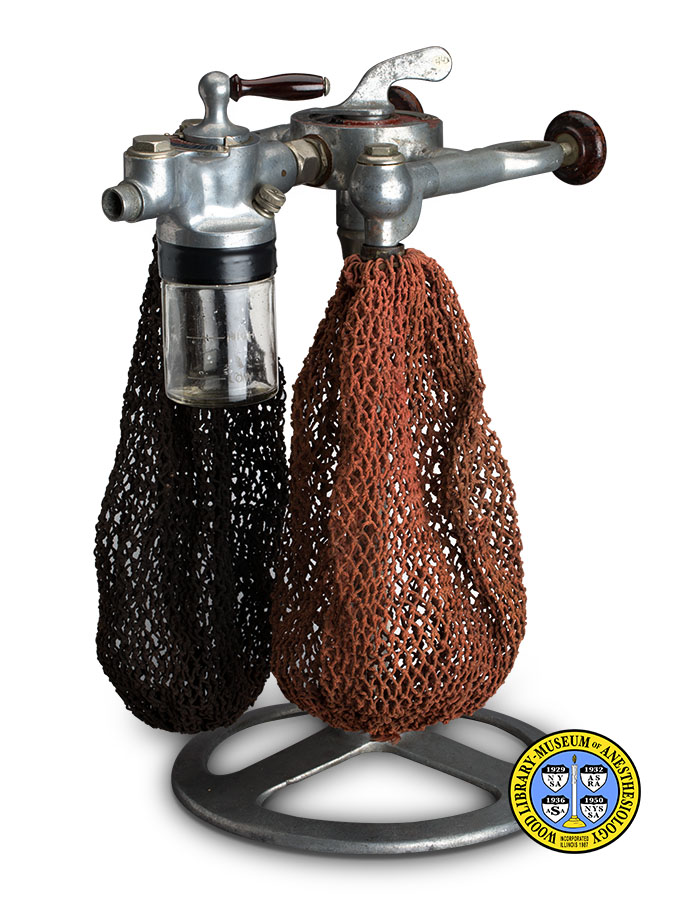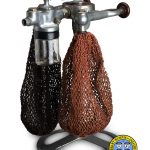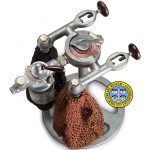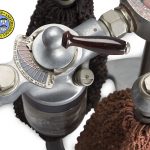Baby Clark Gas Outfit
Chicago inventor Albert Charles Clark founded the dental equipment firm, A. C. Clark & Company, in 1895. From 1904 into the 1920s, Clark also made anesthesia machines. Their original model, the Clark Correct Apparatus, was one of the first in the world to administer what would become the standard triad of agents, nitrous oxide, oxygen and ether. Through the 1910s, Clark marketed its New Model Gas Outfit, and the more compact Baby Clark Gas Outfit. But the tide was already turning against this pioneer. Around 1910, Elmer I. McKesson, M.D. (1881-1935) modified the Clark regulating valve, founded his own company, and launched a new generation of anesthesia machines. At the same time, several manufacturers were marketing portable apparatus for obstetrical analgesia (pain relief) and anesthesia. These companies included Foregger, Heidbrink, McKesson, and Teter. The Clark "Baby" may have been named with this competition in mind.
Catalog Record: Baby Clark Gas Outfit Baby Clark Gas Outfit
Access Key: amwr
Accession No.: 443
Title: [Baby Clark Gas Outfit] / A. C. Clark & Co.
Corporate Author: A. C. Clark & Co.
Publisher: Chicago, Ill. : A. C. Clark & Co., [between 1910 and 1920?].
Physical Description: 1 anesthesia apparatus: metals, wood, paint ; 52.5 x 38 x 37 cm.
Subject: Anesthesia, Inhalation.
Subject: Analgesia, Obstetrical.
Subject: Anesthesia Machines.
Subject: Nitrous Oxide.
Subject: Oxygen.
Subject: Ether, Ethyl.
Web Link: https://www.woodlibrarymuseum.org/museum/item/1007/baby-clark-gas-outfit
Note Type: General
Notes: The date range is based on the earliest and latest descriptions of the Clark New Model Gas Outfit, of which this is considered a variant. The cataloger found publications which specifically describe the Baby Clark Gas Outfit dating only from 1915 to 1918.
The front is considered that side which faces the patient, where a vaporizer and hose would attach to the unit. The back is considered that side which would hold the cylinders and their control knobs. When seen from the back all markings are right-side up, and this is the orientation in which the object is described. But if addressed from the back, these markings could be obscured when compressed gas tanks are in place. Also, from this distance it would be difficult to reach the patient. The apparatus might be easiest to use when the operator is seated beside it, rather than behind it.
Note Type: Citation
Notes: A. C. Clark & Company File. Archives. Located at: Wood Library-Museum of Anesthesiology, Schaumburg, Illinois.
Note Type: Citation
Notes: Coburn RC. Nitrous oxide analgesia in labor. New York State Journal of Medicine. February, 1919; 19(2):37-40.
Note Type: Citation
Notes: Davison MHA. The evolution of anaesthesia (Part 2). British Journal of Anaesthesia. October 1958;30(8):504.
Note Type: Citation
Notes: Eger EI, 2nd., Ed. Nitrous Oxide / N2O. New York: Elsevier, 1985.
Note Type: Citation
Notes: McKesson EI. Nitrous oxid-oxygen anaesthesia; with a description of a new apparatus. Surgery, Gynecology and Obstetrics. October, 1911; 13: 456-462.
Note Type: Physical Description
Notes: One anesthesia apparatus; The head of the unit consists of the control dial and the cross bars that hold the gauges, regulators and yokes; This head is mounted on a short pole seated in a circular base with three radial arms or spokes; The manufacturer’s serial number “634” is stamped on the hex nut on the front of the apparatus; The control dial is painted red on the left and black on the right; These colors are applied in the shape of crescents which overlap in the center of the dial; This dial is marked, from left to right: “OFF, OX, N2O, OFF”; A small metal plate affixed to the dial reads “NEW CLARK [new line] PAT. IN U.S. AND FOREIGN COUNTRIES [new line] OTHER PATENTS PENDING [new line] A. C. CLARK & CO., CHICAGO, ILL.”; A metal control knob is seated in the center of this dial; The knob has a teardrop-shaped indicator with an upright flange for a hand grip; The accession number “443” is painted on the right side of this flange; Each yoke holds a screw with a round (not spherical) wooden knob;
A vaporizer is connected to the front of the apparatus; A control knob consisting of a metal stem holding a wooden handle is mounted above this dial; From left to right the control dial of the vaporizer reads “ETHER [new line] ETHER MIXTURE WITH BASIC CASES [new line] BASIC CASES”; This dial is painted blue on the right and red on the left ; These colors are applied in the shape of crescents which overlap in the center of the dial; A metal post rises from the center of this dial; This post holds a wooden handle; Mounted on the right side of the vaporizer head is a small cylindrical valve; This valve is approximately .5 centimeter high and .5 centimeter in diameter; The valve has a sliding door which can be completely closed, or opened to as much as a half-circle in extent, in order to admit, or to exclude, air; For purposes of photography, this unit was married to the glass vaporizer bottle, and two net bags, from another Clark machine in the collection.
Note Type: Reproduction
Notes: Photographed by Mr. Steve Donisch, January 13, 2016.
Note Type: Acquisition
Notes: Gift of Sol Lesinger, M.D.
Note Type: Historical
Notes: The dental equipment firm, A. C. Clark & Company, was founded in Chicago in 1895. From 1904 into the 1920s, Clark also made anesthesia machines. Their original model, the Clark Correct Apparatus, was one of the first in the world to administer what would become the standard triad of agents, nitrous oxide, oxygen and ether.Through the 1910s, Clark marketed its New Model Gas Outfit, and the more compact Baby Clark Gas Outfit. But the tide was already turning against this pioneer. Around 1910, Elmer I. McKesson, M.D. (1881-1935) modified the Clark regulating valve, founded his own company, and launched a new generation of anesthesia machines. At the same time, several manufacturers were marketing portable apparatus for obstetrical analgesia (pain relief) and anesthesia. These companies included Foregger, Heidbrink, McKesson, and Teter. The Clark “Baby” may have been named with this competition in mind.
Note Type: Exhibition
Notes: Selected for the WLM website.




